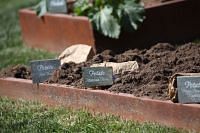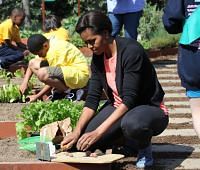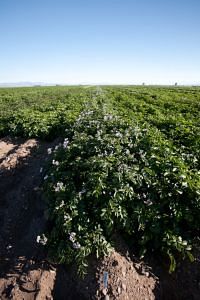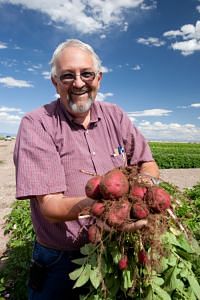The Mountain Rose potato variety can be found in the White House kitchen garden
Colorado State University potatoes well represented in White House Garden

You say potato. I say Colorado.
When First Lady Michelle Obama and a passel of schoolchildren recently planted vegetables in the White House kitchen garden, three of five potato varieties plunked into the soil were developed by Colorado State University.
“It feels good to have Colorado potatoes receive this kind of recognition. When I saw it, I thought, ‘That’s pretty great. I won’t argue with that!’” said David “Spudmaker” Holm, a CSU horticulture professor. Holm led development of the three varieties at the White House.
The types of Colorado potatoes planted in the White House Kitchen Garden were:
- Sangre, a flavorful red-skinned potato with good boiling and baking qualities that’s known to store well and is named for the Sangre de Cristo Mountains;
- Canela Russet, a popular russet that’s great for baking and whose name, in Spanish, means “cinnamon,” a reference to its warm skin color;and
- Mountain Rose, a specialty potato with red skin and pigmented, light-red flesh that’s high in healthful antioxidants.
All of the potato varieties are available to home gardeners during the spring planting season.
The inclusion of potatoes in the First Garden was notable after a vociferous policy debate last fall. The U.S. Department of Agriculture had proposed a limit on white potatoes and other starchy vegetables in public-school meal programs. The plan was aimed at boosting the variety of veggies served to schoolchildren in an era of increasing childhood obesity. The U.S. Senate scuttled the plan.
“I was thrilled to see potatoes planted in the White House garden. I was really excited after the issue with potatoes in school meals,” said Jim Ehrlich, executive director of the Colorado Potato Administrative Committee, which represents Colorado potato growers. “I feel vindicated. Potatoes had been depicted as the villain, and when you work in this field you take that to heart. We feel like we’re providing a nutritious, healthy source of food.”
Planting in the White House vegetable garden was part of Let’s Move!, the First Lady’s campaign to encourage exercise and healthful eating among children.
Want to talk tubers in Colorado?
Potatoes are tops among all fruits and vegetables grown in Colorado, with $156 million in sales in 2010, according to the Colorado Agricultural Statistics report. That number is expected to jump to more than $250 million in sales when 2011 numbers are crunched, an increase attributed to much higher potato prices due to a smaller nationwide crop last year.
Colorado potato farming is centered in the San Luis Valley, an expanse that sits at 7,500 feet elevation and is ringed by the San Juan and Sangre de Cristo mountains. It is known as the highest and largest commercial agricultural valley in the world. Here, spuds rule.
Last year, 55,000 acres of potatoes were planted in San Luis Valley;that’s nearly 90 square miles. Most of these potatoes are grown for the fresh market, and the vast majority – approaching 90 percent – are varieties developed by CSU.
It takes 14 years to develop a new potato variety through the process of crossbreeding, growing and selecting for desirable traits – then identifying, evaluating and certifying the new cultivar.
CSU’s San Luis Valley Research Center, with a potato team of seven people, develops varieties through traditional plant breeding;these potatoes are not genetically modified.
The CSU research team – formally called the Colorado Potato Breeding and Selection Program – works closely with farmers to develop and test successful varieties, said Holm, the project leader (His email name is “spudmkr”).
The team seeks cultivars that will grow vigorously, demonstrate resistance to disease and pests, and require limited fertilizer and fungicide. The CSU potato-breeding program has emphasized environmental sustainability since it began about 60 years ago.
“It’s something we’ve always practiced,” said Holm, project leader for nearly 35 years. “If we can grow a potato without as much nitrogen or as much fungicide, and still produce an acceptable crop, then we’ve made progress. All of our varieties tend to be more sustainable.”
In turn, the Colorado Potato Administrative Committee, representing growers, supports CSU potato research to the tune of about $250,000 a year. This alliance provides critical support for CSU research innovations, and delivers both new knowledge – and new cultivars – that help the Colorado potato industry to thrive.
These days, the potato research team focuses not only on varieties with improved sustainability but on developing cultivars with improved human-health benefits.
The group is particularly interested in pigmented potatoes, with purple and red flesh, that are rich in cancer-fighting polyphenols, carotenoids and other antioxidants.
Mountain Rose, featured in the White House garden, is among these. Another is called Purple Majesty, with deep-purple flesh.
As Mrs. Obama told kids helping in the White House vegetable garden, “Let’s plant!”

















